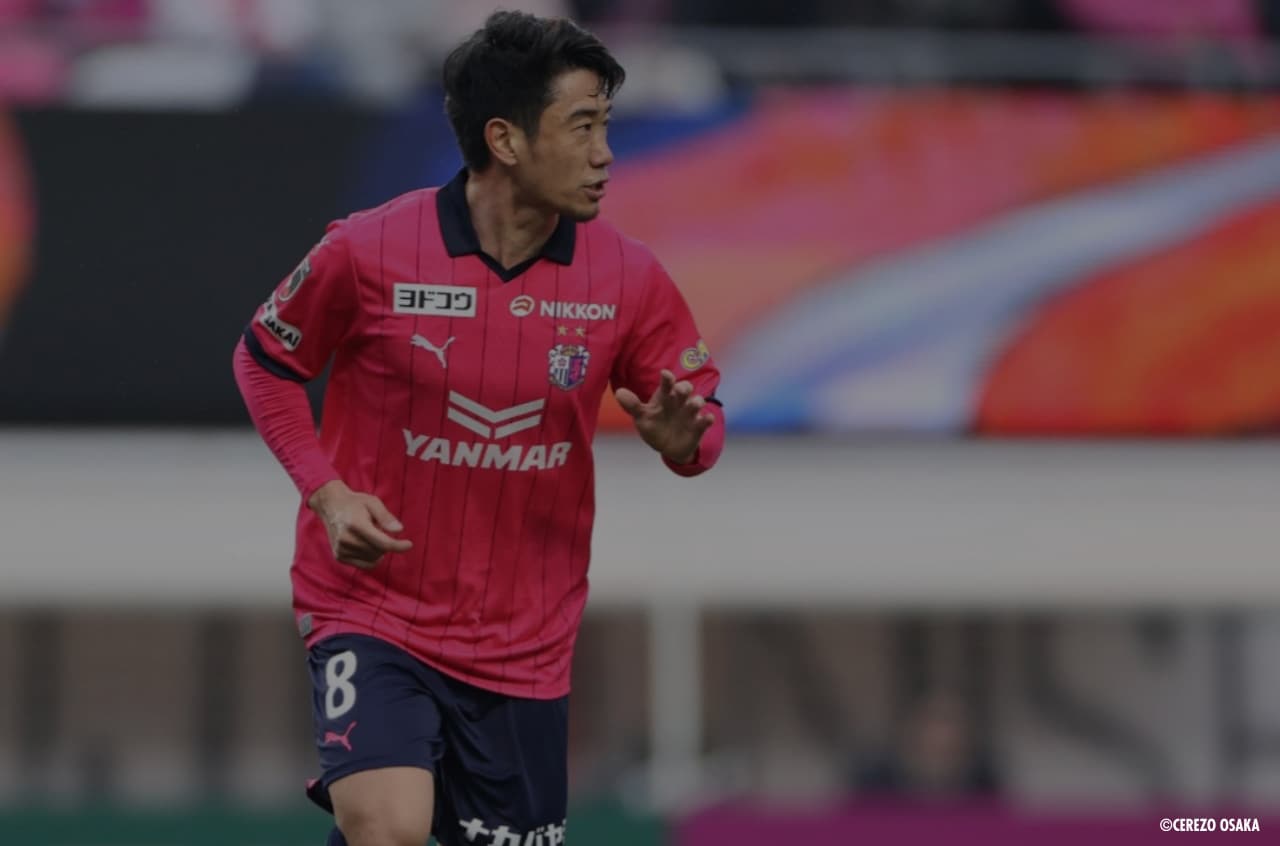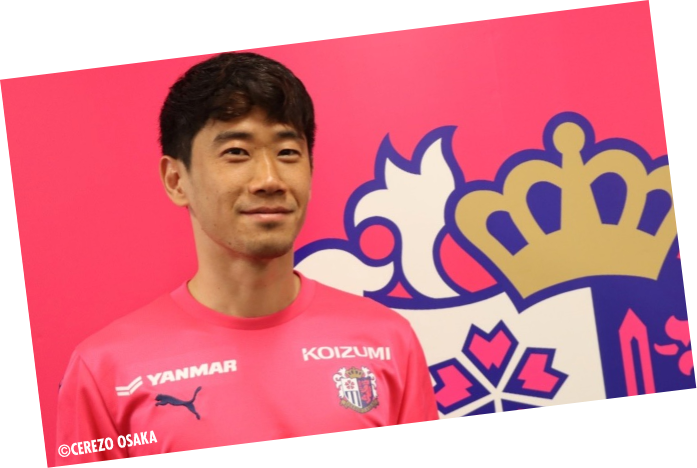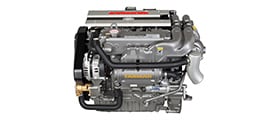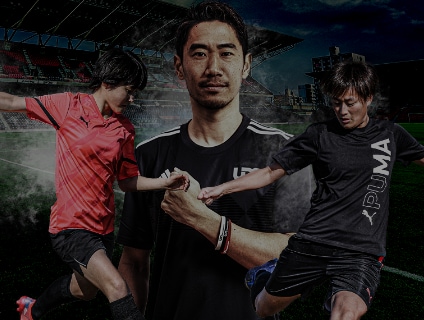
Shinji Kagawa’s

Shinji Kagawa’s Advice for Younger Players “Knowing and Demonstrating Your Own Strengths”
Is Important as a Pro
I prioritized how I felt and decided this was the best timing
Shinji Kagawa is home. He stands on the J. League pitch wearing a pink uniform. “I want to see football being played in a stadium,” he says. When Cerezo Osaka, Kagawa’s old team, announced that he would be returning to Japan on February 1, there were high expectations from Cerezo Osaka supporters as well as a large number of Japanese football fans and supporters.
On February 5, Kagawa announced at a press conference that he would wear number 8. He had the following to say regarding his reason for coming home.
“I had decided to play in Europe until the end of the 2022 World Cup, and after that, I wanted to prioritize how I felt. Around that time, I had [foot] surgery, and I had time to think about the future while I was in rehab. As a result of that, I came to the decision that this was the best timing.”
For twelve and a half years, Kagawa made a solid mark in Europe amidst the intensely competitive environment, demonstrating unmatched performance and amassing one-of-a-kind experience. “I got used to it for the most part.” About a month after he returned to his old team, I interviewed him at the Maishima club house. He answered my questions with a calm expression but strong determination.
Shinji Kagawa
 Cerezo Osaka
Cerezo Osaka
Born March 17, 1989. 34 years old. From Kobe, Hyogo. FC Miyagi Barcelona Junior Youth → FC Miyagi Barcelona Youth → Cerezo Osaka → Dortmund (Germany) → Manchester United (U.K.) → Dortmund → Beşiktaş (Turkey) → Dortmund → Zaragoza (Spain) → PAOK Thessaloniki (Greece) → Sint-Truidense V.V. (Belgium). Competed in 13 J1 League games, scoring 7 goals and 114 J2 League games, scoring 48 goals (as of March 2). Competed in 97 Japan National Team “A” matches, scoring 31 goals.

Hearing the cheers made me happy to be supported
February 18, 2023, Yodoko Sakura Stadium. In the Meiji Yasuda J1 League 1st Sec. match against Albirex Niigata, Kagawa went in as a substitute at the 71-minute mark, when the game was tied 1-1. It was his first time on the J. League pitch since May 15, 2010, when his direct free kick decided the 12th Sec. match against Vissel Kobe. Twelve and a half years had passed, and the once 21-year-old youth was now 33 years old.
- When you were last a member, the training facility was in Minamitsumori. Now it’s in Maishima. When you came back to Japan, how did you feel about the changes in the club house and the environment in general?
- The environment is amazing. Coming back, the medical staff are all hard-working people, and everyone is working for the good of the players. On the other hand, the players have to play responsibly without getting spoiled by this environment.
- You mentioned the medical staff. Is understanding the language an important part when communicating subtle details?
- It is, and having been in Europe, I can especially appreciate Japan’s high level when it comes to medical teams. I appreciate their delicacy, detail, and above all, that they put their all into caring for the players. There are also a wide range of treatment options available, which is very helpful.
- You came in partway through the J1 season-opening game against Niigata, which was your first game since returning home. How did you feel standing on the pitch at Yodoko Sakura Stadium, seeing the pink all around and hearing the cheers of supporters?
- The atmosphere at the stadium was great, including behind the goal. Of course, having been gone for more than ten years, it’s natural that the fans and the stadium have changed and evolved, but I was very grateful. I want to create an atmosphere in which I can win at home, and the power of supporters is the most important part of that. I want to be a team that always plays in a packed house at home.
- The club’s previous home, Yanmar Stadium Nagai, had a high capacity but was rarely packed.
- I like Nagai, as well. I would like to play there sometimes, too (laughs). I have an emotional attachment to that stadium, so I would be happy for a chance to play there again.
- Since Yodoko Sakura Stadium is a football-only stadium, does it feel tightly concentrated in a European way?
- I did feel that when standing on the pitch. It was a good atmosphere to play in with the pressure and heat of the supporters. The environment also allows supporters to cheer loudly, so I think it will get better and better as a stadium.
- You said, “When I got to the stadium and heard the cheers of the fans and supporters, it flipped on a switch again. That was also the moment that made it feel like the season had begun.”
- Hearing those cheers renewed my feeling of happiness at being supported. There were a lot of trials over the past several years, but the reaction of the supporters at that game made me truly grateful. It was a huge motivation. I felt a lot of different emotions in the lead-up to the game, but they created an atmosphere where I could just concentrate on the game. The energy that the fans and supporters create for us when we enter the stadium–-that power to flip on the switch that says, “Alright, let’s do this”–-is extremely important to us as players. I want to keep having the kind of relationship with supporters where we rely on that and achieve solid results on the pitch.
- Seeing you out there on the pitch playing really drove home for me the fact that you had come back to Cerezo.
- For me, it doesn’t really matter that I’ve been away for twelve and a half years; I am only thinking about the future. Frankly, I’m not interested in the past. How I will build up going forward is more important. I’m glad that I’ve have the opportunity to experience the atmosphere of the new stadium and take that first step.
In Europe, surviving every day was a battle; daily practice was a battle
It was the summer of 2010 when Kagawa transferred from Cerezo Osaka to Borussia Dortmund, a club in the German Bundesliga. Carrying the hopes of Japan and the team colors of yellow and black, the young warrior of 21 won consecutive championships and created a frenzy in the Bundesliga. Subsequently, he transferred to Manchester United in the Premier League, where he played in six countries including United Kingdom, Germany, Turkey, Spain, Greece, and Belgium.

- You competed in Europe for twelve and a half years. What did you feel most strongly during your time playing overseas?
- There were good parts and bad parts. Most of all, being a foreign player, I ultimately had to break through on my own. No one could help me; I had to overcome it by myself. That was the biggest difference in the environment from Japan. There was also very strong pressure from the fans and the media. That’s something I didn’t know until I went. I learned a lot from going to Europe. However, rather than thinking about how things are now that I’ve come back to Japan from Europe, I want to hold on the feeling that I’ll always be learning and growing going forward.
- Is there inevitably more time to face yourself overseas?
- It’s not necessary to compare it with Japan, but simply put, the competition is fiercer when playing in Europe. Players who are routinely competing in such an environment are tougher.
- You said that every year was a battle.
- Every day is a battle. Daily practice is a battle. I felt a nervous tension during training every day. The higher your level, the more is expected of you, and even a single mistake is noticed. It’s a world where you’ll get tripped up if you aren’t well prepared to keep fighting. The only way to survive is to prove that you’re a good player at practice every day. If you show even a little weakness, it becomes impossible to break out of the slump. It’s a matter of how well you can control those feelings and keep fighting.
- Is that experience playing in Europe a major factor that has made you who you are today?
- Of course. The experience I gained is very significant for me going forward, and I want to hold on to the way I felt in Europe as I continue to play going forward.
Even if things don’t go well in junior high and high school, don’t give up
Nowadays, many young players are taking on the challenge of transferring overseas. Kagawa, who was a pioneer for Cerezo Osaka, was followed by Hiroshi Kiyotake, Takumi Minamino, and others. Sota Kitano, an 18-year-old player currently aiming to represent Japan in the U-20 World Cup, has also spoken clearly about his goal of playing in a big international club.
As a senior player who has survived the fierce competition in Europe, what advice can Kagawa give his young juniors?

- Do you have any advice for current Cerezo Academy students who dream of succeeding in Europe like you?
- If you want to compete in the world of professionals, you just have to get a firm grasp of your strengths and assert yourself and demonstrate them on the pitch. It’s really simple. Think about how badly you want to succeed internationally, and work that much harder in your training. You also have be mentally prepared to keep fighting.
- It’s important to build those kinds of principles and foundations when you’re young. The mentality created during junior high and high school will be a tremendous support even after going pro. To put it the other way around, if you’ve slacked off there, you won’t succeed as a pro. It’s a tough world. If you’re going to do it, you have to aim for the top, and in order to do that, “now” is extremely important. It’s a matter of how hard you work, whether you practice more than others to improve your technique, and how you demonstrate your strengths on the pitch. If you don’t keep working as hard as you can to do that, there will always be someone better than you.
- And most of all, you should learn the skills needed to overcome setbacks and frustrating moments. In my experience, players who experience frustration and things going wrong are the ones who end up on top. Even if things don’t go well in junior high and high school, don’t give up so easily; keep fighting. It’s a matter of how focused on details you can be.
- Take it steadily, one step at a time. I was in the same position once. Frankly, I never could have imagined that I would be playing for teams like Borussia Dortmund and Manchester United, or wearing number 10 for Japan. But you never know what will happen. The same goes for timing and encounters. Always appreciate those things.
- So, in order to reach the top, technique is obviously important, but mentality is also essential?
- It’s extremely important. Things hardly ever go how you expect, so it’s a matter of being able to keep working hard with a positive mindset. It’s a simple way of thinking that I like.
- What are you goals now that you’re back at Cerezo Osaka?
- I want to keep working hard in daily training and matches while thinking about how to achieve the club’s ultimate goals of winning a title and becoming top 3 in the future. Working backwards, there are a lot of things that we have to do as part of the process. I can imagine a lot of different scenarios.
- However, the most important thing is doing my best in daily training. I can’t lose sight of that. If I don’t concentrate on what’s right in front of me, even if my head is full of ideals, things won’t work out. It’s important to head into matches every weekend with a good balance between the two. We’ve played two losing games so far, so it’s a matter of first winning a game, then figuring out how to improve as a team. I’m always thinking about that.
- What is your current driving force as you continue playing?
- I strongly believe that I can still grow and become a better player. That’s my driving force. Once that’s gone, I’m ready to quit. But I truly feel that I can still grow, become a better player, and make a positive contribution to the team, so I’m really excited to keep playing. My underlying desire to keep growing has not changed since my early days of playing football. I hope to keep that mentality as long as I’m alive.

Cerezo Osaka, the power of the academy
 for the future
for the future
Cerezo Osaka Academy aims to develop world-class player. From Cerezo Osaka to the world.
"We want many beautiful flowers to bloom in the future."
We approach the driving force for such a future.


Athlete's

Why do top athletes keep challenging?
We approach the driving force of top athletes who continue to challenge.























